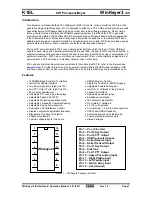19.3.3.2 8-bit Timers with Auto-Reload (Split Mode)
When TnSPLIT is set, the timer operates as two 8-bit timers (TMRnH and TMRnL). Both 8-bit timers operate in auto-reload mode.
TMRnRLL holds the reload value for TMRnL; TMRnRLH holds the reload value for TMRnH. The TRn bit in TMRnCN handles the run
control for TMRnH. TMRnL is always running when configured for 8-bit auto-reload mode. As shown in the clock source selection tree,
the two halves of the timer may be clocked from SYSCLK or by the source selected by the TnXCLK bits.
The overflow rate of the low timer in split 8-bit auto-reload mode is:
F
TIMERn Low
=
F
Input Clock
2
8
– TMRnRLL
=
F
Input Clock
256 – TMRnRLL
The overflow rate of the high timer in split 8-bit auto-reload mode is:
F
TIMERn High
=
F
Input Clock
2
8
– TMRnRLH
=
F
Input Clock
256 – TMRnRLH
The TFnH bit is set when TMRnH overflows from 0xFF to 0x00; the TFnL bit is set when TMRnL overflows from 0xFF to 0x00. When
timer interrupts are enabled, an interrupt is generated each time TMRnH overflows. If timer interrupts are enabled and TFnLEN is set,
an interrupt is generated each time either TMRnL or TMRnH overflows. When TFnLEN is enabled, software must check the TFnH and
TFnL flags to determine the source of the timer interrupt. The TFnH and TFnL interrupt flags are not cleared by hardware and must be
manually cleared by software.
TMRnH
TMRnRLH
Reload
Reload
TCLK
TMRnRLL
Interrupt
TFnL
Overflow
TFnLEN
TMRnL
TFnH
Overflow
TRn
Timer High Clock
Timer Low Clock
Figure 19.7. 8-Bit Split Mode Block Diagram
EFM8UB3 Reference Manual
Timers (Timer0, Timer1, Timer2, Timer3, Timer4, and Timer5)
silabs.com
| Building a more connected world.
Rev. 0.2 | 266


















